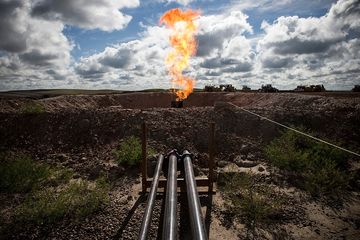Economy
Oil’s Crash Deepens in Tug-of-War Between Virus and Stimulus

(Bloomberg) — Oil’s spectacular collapse deepened as investors weighed measures by governments and central banks to help shore up the global economy against the spreading coronavirus with the market poised for the biggest ever annual contraction in consumption.
Futures in London fell as much as 6.6% after plunging by a quarter last week — the largest weekly drop since 2008. Travel restrictions across the globe tightened further over the weekend in efforts to contain the spread of the virus, with the U.S. extending its travel ban to include Britain and Ireland. Australia said anyone entering the country must self-isolate for two weeks, Spain imposed a lockdown and France closed cafes and restaurants.
The sharp slow down in activity brought on by the virus is being compounded by a potential flood of supply in April, with top producers Saudi Arabia and Russia pledging to ramp up production. The Middle East kingdom doubled down on the war for market share last week by sending a wave of crude to Europe, Russia’s traditional market, further dimming the likelihood of a reconciliation.
The plunge in crude consumption, which averaged just over 100 million barrels a day in 2019, could easily outstrip the loss of almost 1 million barrels a day during the great recession in 2009 and even surpassing the 2.65 million barrels registered in 1980, when the world economy crashed after the second oil crisis.
“Global financial markets are being rattled by the growing severity of the coronavirus and at the same time spooked by the enormity of the stimulus measures to combat it,” said Vandana Hari, founder of Vanda Insights in Singapore. “If the pandemic continues to worsen across the globe, oil will head lower. If it worsens in the U.S., belt up for an apocalypse.”
The concurrent demand and supply shocks hitting the oil market appeared to prevail over efforts to shore up the global economy. The Federal Reserve on Sunday cut its benchmark rate by a full percentage point to near zero and will boost its bond holdings by at least $700 billion. That followed President Donald Trump on Friday announcing the U.S. government would buy oil to fill its strategic petroleum reserve.
Brent crude for May slid $1, or 3%, to $32.85 a barrel as of 9:41 a.m. in Singapore. Futures fell 25% last week to $33.85, the largest weekly drop since December 2008. West Texas Intermediate for April delivery traded 2% lower at $31.10 on the New York Mercantile Exchange, recovering from a 6.2% drop earlier.
Travel restrictions within the U.S. are threatening demand for motor fuel. Gasoline futures’ premium to oil fell to as little as $3.03 a barrel on the Nymex. It was $17 on March 6.
The Fed’s weekend move could trigger a fresh round of monetary easing around the world as countries look to keep money flowing as economic activity grinds to a halt. New Zealand’s central bank slashed rates by 75 basis points on Monday. The scale of the task facing economic policy makers is likely to be laid bare later on Monday, with the latest numbers on China’s industrial output, investment and retail sales forecast to show an across-the-board contraction for the first time on record.
“The market is trying to weigh up between the Fed rate cut, quantitative easing and the fact that the situation is a lot worse than we all thought,” said David Lennox, an analyst at Fat Prophets. “We’ve seen that huge panic sell-off, so it could be that there is limited downside from here.”
–With assistance from Sharon Cho and Dan Murtaugh.
-

 Alamaliktistaad Magazines2 months ago
Alamaliktistaad Magazines2 months agoAlam Al Iktisaad – September 2025 Edition
-

 News2 months ago
News2 months agoKitchenomiKs Secures Investment of US$3.2M Led by Jasoor Ventures
-

 Banking & Finance2 months ago
Banking & Finance2 months agoOman Arab Bank Highlights Its Ongoing Strategic Initiatives and Future Plans
-

 News2 months ago
News2 months agoIEA Expects Global Oil Market to Remain Oversupplied in 2026
-

 Energy2 months ago
Energy2 months agoWLGA Middle East LPG Summit & Expo 2025 to be held at OCEC on November 10 and 11
-

 Real Estate2 months ago
Real Estate2 months agoAl Mouj Muscat Unveils Azura Beach Residences Phase 2: A New Chapter in Waterfront Living
-

 Leaders Speak1 month ago
Leaders Speak1 month agoDhofar International Development and Investment Company: Driving Sustainable Growth and Strategic Synergies in Oman’s Investment Landscape
-

 Events1 month ago
Events1 month agoOER Corporate Excellence Awards 2025 Honours Entities and Innovations in Oman






























